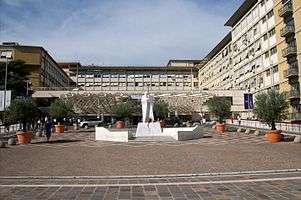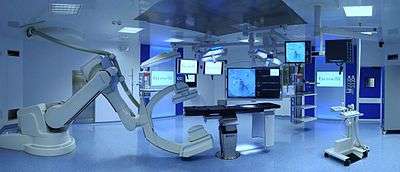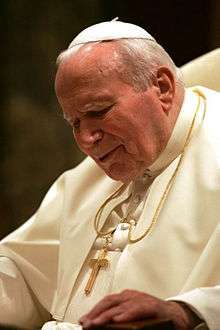Agostino Gemelli University Polyclinic
| Fondazione Policlinico Universitario Agostino Gemelli | |
|---|---|
 | |
| Geography | |
| Location | Rome, Lazio, Italy |
| Organisation | |
| Hospital type | General |
| Affiliated university | Università Cattolica del Sacro Cuore |
| Services | |
| Emergency department | Yes |
| Beds | 1,558 |
| History | |
| Founded | 1964 |
| Links | |
| Website | http://www.policlinicogemelli.it/ |
| Lists | Hospitals in Italy |
The Gemelli University Hospital (Italian: Fondazione Policlinico Universitario Agostino Gemelli) is a large general hospital in Rome, Italy. With 1558 beds, it is the second largest hospital in Italy, the largest hospital in Rome and one of the largest private hospitals in Europe.[1] It serves as the teaching hospital for the medical school of the Università Cattolica del Sacro Cuore (the largest privately owned university in Italy, founded in 1921 in Milan), and owes its name to the university founder, the Franciscan friar, physician and psychologist Agostino Gemelli. The hospital provides free medical assistance as part of the Italian national health system as well as paid-for "private" assistance in dedicated hotel-style wards.
History and Structure
Construction began in 1959 on the hill of Monte Mario in Rome, and the hospital opened its doors in July 1964. The hospital hosts facilities for both basic and clinical research, on-site housing for medical students, canteens, cafeterias, one restaurant, one bookshop and two medical libraries.[2]
Undergraduate and postgraduate Medical studies, Nursing sciences, Physiotherapy and a variety of other clinical subjects takes place at the main building. Four further buildings are open to the public: the "Biological Institutes", the "Protected Health Residence", the combined "Institute of Infectious Diseases" and "Centre for the Medicine of Aging".
In the early 2000s, a new building was added to the main body, which hosts the Accident and Emergency department, most of the operating theatres and several laboratories.[3] The buildings are surrounded by parks and meadows. The original manorial villa, built long before the site was chosen to build the hospital and previously used as a convent, now serves as the Institute of Bioethics, as well as the main university Church.

Organizational Model and activity
Since 2015, the Hospital is organized into 21 areas grouped in 8 departments, whose aim is to coordinate healthcare, training, education and research roles assigned to the areas they cover. The Hospital uses "Critical Pathways" to map, integrate and assess every phase involved in providing care for key health problems.
In 2015 alone, almost 95,000 patients were hospitalised and more than 45,000 surgical operations were conducted. 80,000 patients where treated in the Emergency Department, 10,000 blood dialysis sessions and more than 6 millions of radiological procedures were conducted. The hospital staff includes more than 5,000 employees, of whom almost 1000 physicians and more than 2,000 nurses. Every day, the hospital premises and the whole campus host an estimated number of 30,000 people.[4]
Each year the hospital consumes around 50 million kWh and 16 million cubic metres of natural gas. Its co-generation system provides around 60% of the energy that is needed for electricity, heating and cooling, making it one of the largest infrastructures of this kind in the civil and hospital sectors in Italy. Compliance with existing regulations have resulted in the Hospital obtaining ISO 50001 certification from the Bureau Veritas agency. Gemelli Hospital was the first teaching hospital in Italy ever to receive this certification.[4]
The Hospital and the University are focused on research: in 2015 alone, 1500 scientific papers were published, with 323 scientific experiments underway and 17 patents developed by internal researchers thanks €16,000,000 research fundings, provided both by Italian, European and international agencies.[4]
Advanced technologies and areas of excellence

Since 2015, the hospital hosts one of the largest and newest hybrid operating theatres in Europe,[5] a highly specialised Oncological Radiotherapy Center (Gemelli ART) unique in Ialy[6] and the NEMO (NEuroMuscular Omnicentre) Clinical Center, highly specialized in taking care of people affected with neuromuscular diseases including Amyotrophic lateral sclerosis (ALS), Spinal Muscular Atrophy (SMA) and Muscular Dystrophies.[7] More recently, a 1,200 sqm center dedicated to medical, surgical and diagnostic simulation (IPSE Center, Interactive Patient Simulation Experience) has been inaugurated.[8]
The Gemelli is one of Italy’s top centres for colorectal tumours, as well as tumours of the stomach, liver, biliary system and pancreas, and also for transplants. The Endocrinology-Metabolic Diseases Area has clinical-surgical units specialised in managing the main endocrine and metabolic illnesses. The hospital boasts one of Italy’s leading case statistics in terms of management and medical-surgical therapy for diseases of the thyroid, adrenal gland and pituitary gland. The mortality rate for cardiac surgery is among the lowest in Italy.[9]
Medicinema
In 2015, in collaboration with the MediCinema Italy Onlus, the Hospital completed and inaugurated the 130 seats MediCinema theatre which can accommodate patients in wheelchairs and beds . It is the first hospital in Italy to have premises set aside for “cinematherapy” and relief therapy for patients and their family members.[10]
Pope John Paul II and other notable patients

The Gemelli became the focus of international attention during the pontificate of Pope John Paul II who, in 1981, received emergency surgery after Mehmet Ali Ağca's failed assassination attempt. He returned at various times, up to a few weeks before his death in 2005.[11] Other famous ex-patients include politicians Giulio Andreotti, Walter Veltroni and Francesco Cossiga, the Nobel Peace Price Mother Teresa, theoretical physicist Stephen Hawking, priest Georg Ratzinger (elder brother of Pope Benedict XVI), footballers Francesco Totti and Daniele De Rossi and Canadian filmmaker Damian Pettigrew to name a few.[12] In June 2009 a statue of Pope John Paul II was unveiled in front of the hospital building.
References
- ↑ "Italian hospitals by bed count". Italian Ministry of Health. 20 April 2015.
- ↑ "History of the Hospital". policlinicogemelli.it. Retrieved 12 March 2017.
- ↑ "Al via il nuovo Pronto Soccorso del Gemelli". CattolicaNews. 16 July 2015. Retrieved 12 March 2017.
- 1 2 3 "2015 Sustainability report" (PDF). policlinicogemelli.it. Retrieved 12 March 2017.
- ↑ "Gemelli, inaugurata "sala ibrida" per chirurgia cardiovascolare avanzata". Repubblica. 30 October 2014. Archived from the original on 2016-08-21. Retrieved 12 March 2017.
- ↑ "Gemelli ART, nuovo Centro di Radioterapia Oncologica avanzata tra arte, alta tecnologia e accoglienza". Repubblica. 30 October 2014. Retrieved 12 March 2017.
- ↑ "Malattie neuromuscolari, al Policlinico Gemelli un centro "Nemo"". RAI News. 22 September 2015. Retrieved 12 March 2017.
- ↑ "Il "Gemelli" inaugura Ipse Center, centro hi-tech di simulazione ad alta fedeltà". Il Sole 24 ore. 9 March 2017. Retrieved 12 March 2017.
- ↑ "2014 bulletin of the Italian Society for Cardiac Surgery" (PDF). Italian Society for Cardiac Surgery. Retrieved 12 March 2017.
- ↑ "Gemelli, il cinema come terapia del sollievo". Repubblica. Retrieved 12 March 2017.
- ↑ "The Gemelli: the Pope's Hospital". BBC News. 2 February 2005. Retrieved 12 March 2017.
- ↑ "Stephen Hawking hospitalised in Rome". Telegraph UK. 2 December 2016. Retrieved 12 March 2017.
